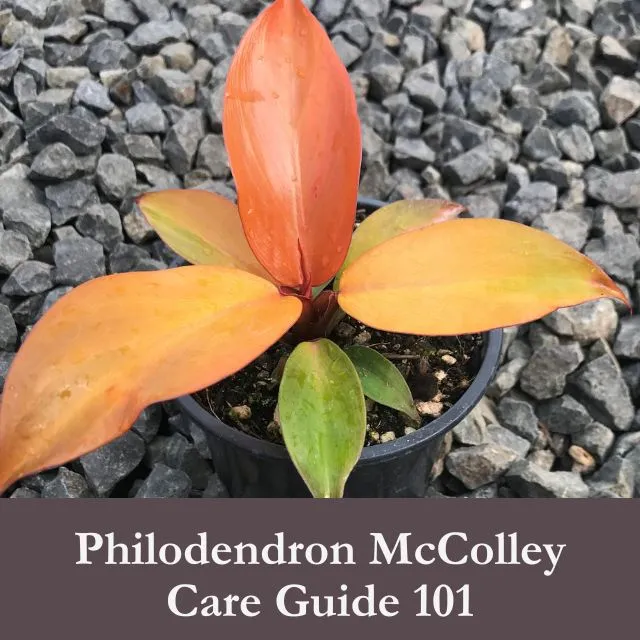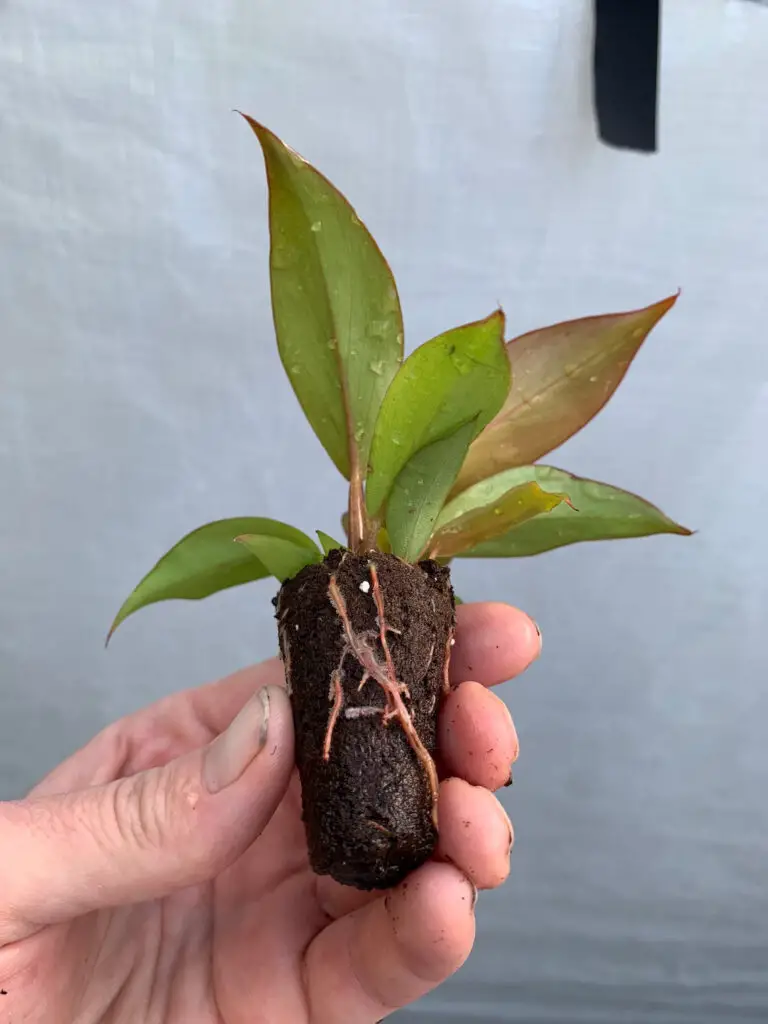Philodendron McColley is a cultivar of the famous tropical plant species Philodendron bipinnatifidum, also known as Philodendron Selloum. The McColley cultivar was developed by the McColley family in Florida and is distinguished by its more prominent and deeply divided leaves compared to the standard Philodendron Selloum.
Philodendron McColley is a hardy plant that can grow up to 6 feet tall and wide, with glossy green leaves reaching up to 4 feet in length. It is a popular choice for indoor and outdoor landscaping due to its attractive foliage and ability to thrive in various lighting conditions.
As with other Philodendron species, Philodendron McColley is relatively easy to care for and can adapt to various environments. It prefers bright, indirect light and well-draining soil and should be watered regularly but not overwatered. With proper care, Philodendron McColley can live for many years and make a beautiful addition to any home or garden.

Characteristics of Philodendron McColley
Philodendron McColley is a cultivar of the Philodendron bipinnatifidum species, also known as Philodendron Selloum.
In addition, it may also be referred to by some of its cultivar names, such as McColley’s Finale, McColley’s Glory, or McColley’s Wonder.
However, the most commonly used term for this cultivar is Philodendron McColley. Here are some of its characteristics:
- Large leaves: Philodendron McColley has large, deeply divided leaves that can reach up to 4 feet long. The leaves are glossy and have a deep green color.
- Hardy plant: This plant is hardy and can grow up to 6 feet tall and wide.
- Indoor/outdoor plant: Philodendron McColley is a popular choice for indoor and outdoor landscaping.
- Adaptable: This plant is adaptable and can thrive in a range of lighting conditions, from bright indirect light to partial shade.
- Easy to care for: Philodendron McColley is relatively easy to care for and can adapt to various environments. It prefers well-draining soil and regular watering but should not be overwatered.
- Long-lived: With proper care, Philodendron McColley can live for many years, making it a popular choice for long-term indoor and outdoor landscaping.
Overall, Philodendron McColley is a beautiful and versatile plant that can add a tropical touch to any space.
Complete Philodendron McColley Care Guide
Here is a complete care guide for Philodendron McColley:
Light Requirements
Philodendron McColley prefers bright, indirect light but can also tolerate partial shade. Direct sunlight can burn the leaves, so keeping them in a spot with filtered or indirect light is best.
Water Requirements
Water your Philodendron McColley regularly, but be careful not to overwater it. Allow the top inch of soil to dry out before watering again. Overwatering can cause root rot, so make sure the soil is well-draining.
Humidity Requirements
Philodendron McColley thrives in humid conditions but can also adapt to lower humidity levels. To increase humidity, you can mist the leaves with water or place a water tray near the plant.
Soil Requirements
Use well-draining soil that retains moisture but doesn’t get waterlogged. A mix of peat moss, perlite, and vermiculite works well.
Fertilizer Requirements
Philodendron McColley benefits from regular fertilization during the growing season (spring and summer). Use a balanced fertilizer every 2-3 weeks or a slow-release fertilizer every 3-4 months.
Pruning Requirements
Prune your Philodendron McColley to control its size and shape. You can also remove any yellow or brown leaves to promote new growth.
Temperature Requirements
Philodendron McColley prefers warm temperatures between 65-80°F (18-27°C). Avoid exposing it to cold drafts or temperatures below 55°F (13°C).
By following these care tips, you can help your Philodendron McColley thrive and add a beautiful tropical touch to your indoor or outdoor space.
Also, Check: Philodendron Florida Ghost: How to Care for the Ghostly Beauty
Propagation of Philodendron McColley
Philodendron McColley can be propagated through stem cuttings. Here’s how to do it:
- Choose a healthy stem: Select a healthy stem with a few leaves and a node. The node is where the roots will form.
- Cut the stem: Use a clean, sharp knife or scissors to cut the stem just below a node.
- Prepare the cutting: Remove leaves from the stem’s lower part, leaving a few at the top. If desired, you can dip the cut end of the stem in rooting hormone to promote root growth.
- Rooting in water: Place the stem cutting in a jar or vase filled with water, ensuring the node is submerged. Change the water every few days and wait for roots to form. Once the roots are about an inch long, you can plant the cutting in soil.
- Rooting in soil: Plant the stem cutting in a pot filled with well-draining soil. Water the soil and cover the pot with a plastic bag to increase humidity. Keep the soil moist and wait for roots to form.
- Care for the new plant: Once the roots have formed and the new plant grows, you can care for it like a mature Philodendron McColley.
Propagation is a great way to create new Philodendron McColley plants and expand your collection. You can successfully propagate this plant through stem cuttings with a little patience and care.

Common Problems & Solutions
Here are some common problems that Philodendron McColley owners may encounter:
Overwatering
Philodendron McColley is susceptible to root rot if it’s overwatered.
To avoid this, make sure the soil is well-draining and allow the top inch of soil to dry out before watering again.
Pests
Common pests that can affect Philodendron McColley include spider mites, mealybugs, and scale.
Treat any infestations with insecticidal soap or neem oil.
Brown or yellow leaves
Brown or yellow leaves can be a sign of overwatering, underwatering, or too much direct sunlight.
Adjust your watering and lighting accordingly.
Drooping leaves
Drooping leaves can be a sign of underwatering or overwatering.
Check the soil moisture level and adjust your watering routine.
Lack of growth
If your Philodendron McColley isn’t growing, it may not be getting enough light or nutrients.
Move it to a brighter spot and consider fertilizing it more frequently.
Root-bound
Philodendron McColley can become root-bound if it’s not repotted regularly.
If you notice the roots growing out of the bottom of the pot or the plant becoming too large for its container, it’s time to repot it into a larger pot.
Toxicity
Philodendron McColley is toxic to pets and humans if ingested. It contains calcium oxalate crystals, which can cause irritation and swelling in the mouth, tongue, and throat. Consuming large quantities can also lead to digestive issues such as nausea and vomiting. It’s important to keep this plant out of reach of children and pets and to seek medical attention immediately if ingestion occurs.
Conclusion
In conclusion, Philodendron McColley is a beautiful and popular houseplant that is relatively easy to care for. By providing it with bright, indirect light, well-draining soil, and regular watering and fertilization, you can help it thrive.
Propagation can be done through stem cuttings, and common problems such as overwatering and pests can be addressed with proper care and attention.
However, it’s important to note that Philodendron McColley is toxic to pets and humans if ingested, so it’s crucial to keep it out of reach and seek medical attention if ingestion occurs. With proper care and caution, Philodendron McColley can be a stunning addition to any indoor plant collection.
Also, Check: Philodendron Squamiferum Care & Propagation ( Step by Step Guide)
Frequently Asked Questions about Philodendron McColley
Can Philodendron McColley grow in low light?
Philodendron McColley prefers bright, indirect light but tolerates lower light conditions. However, if it’s placed in a low-light area, its growth may slow down.
How often should I water my Philodendron McColley?
Water your Philodendron McColley regularly, but be careful not to overwater it. Allow the top inch of soil to dry out before watering again. Depending on the environment, this may occur once a week or every two weeks.
Can I grow Philodendron McColley outside?
Philodendron McColley is a tropical plant and can be grown outdoors in warm, humid climates. It prefers partial shade and well-draining soil.
How often should I fertilize my Philodendron McColley?
Philodendron McColley benefits from regular fertilization during the growing season (spring and summer). Use a balanced fertilizer every 2-3 weeks or a slow-release fertilizer every 3-4 months.
How can I promote bushier growth in my Philodendron McColley?
To promote bushier growth, you can pinch off the tips of new growth or prune the plant back. This will encourage it to produce more branches and leaves.
